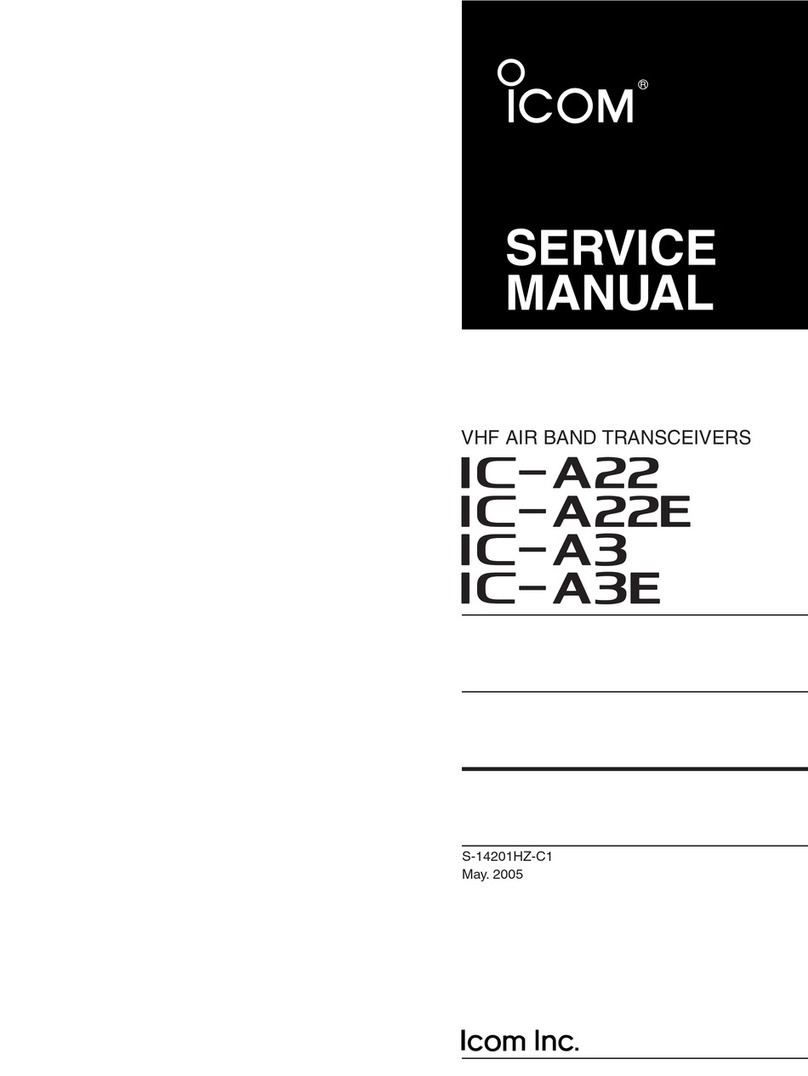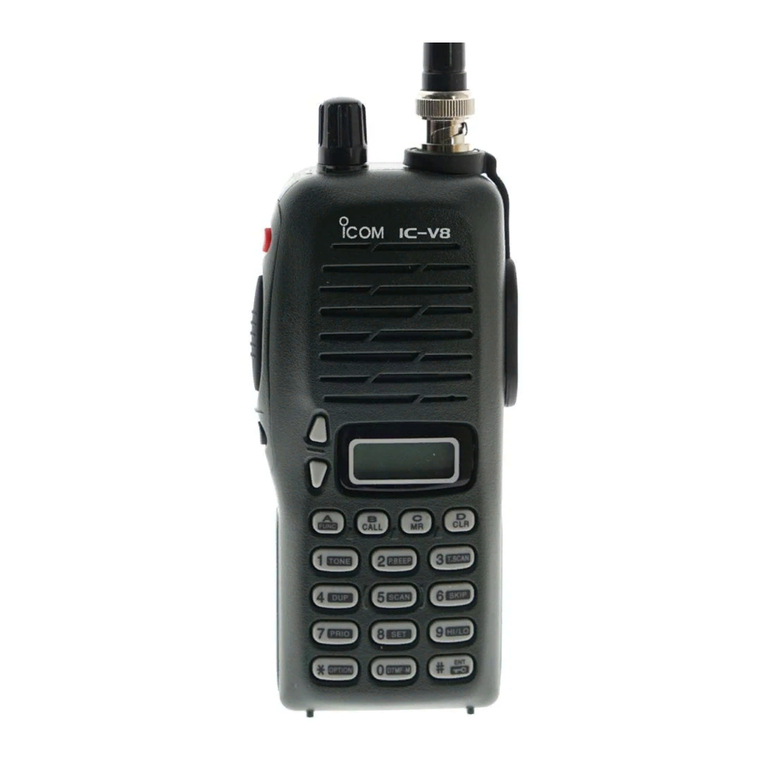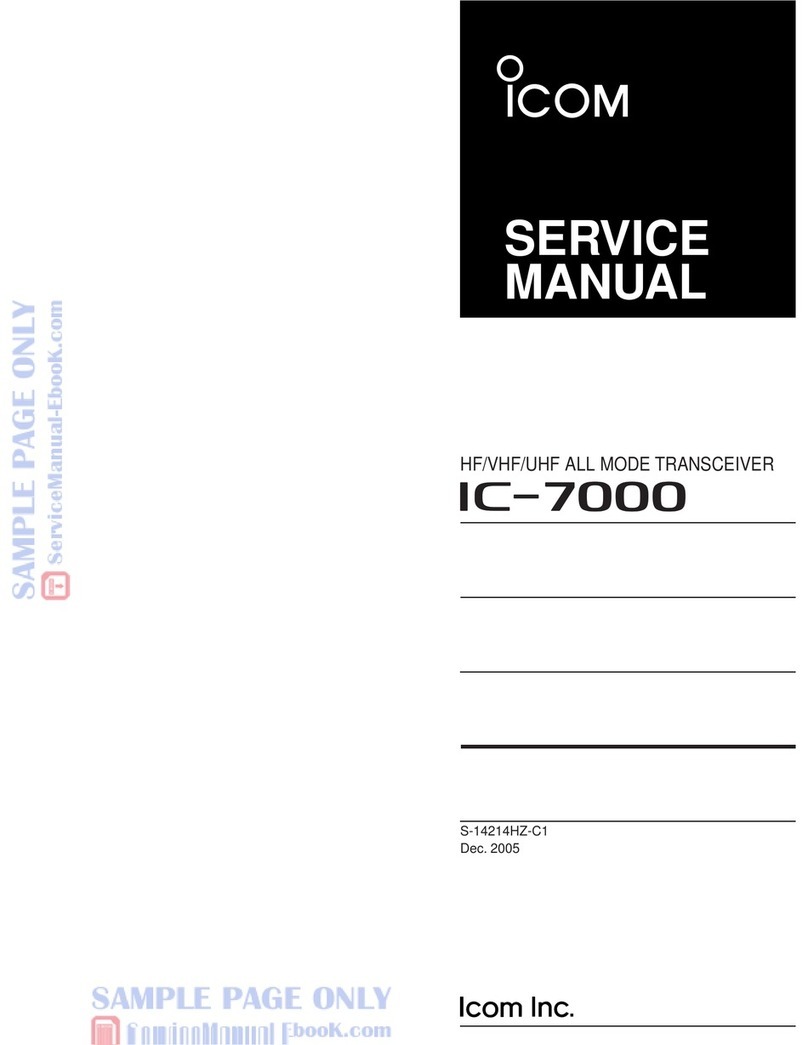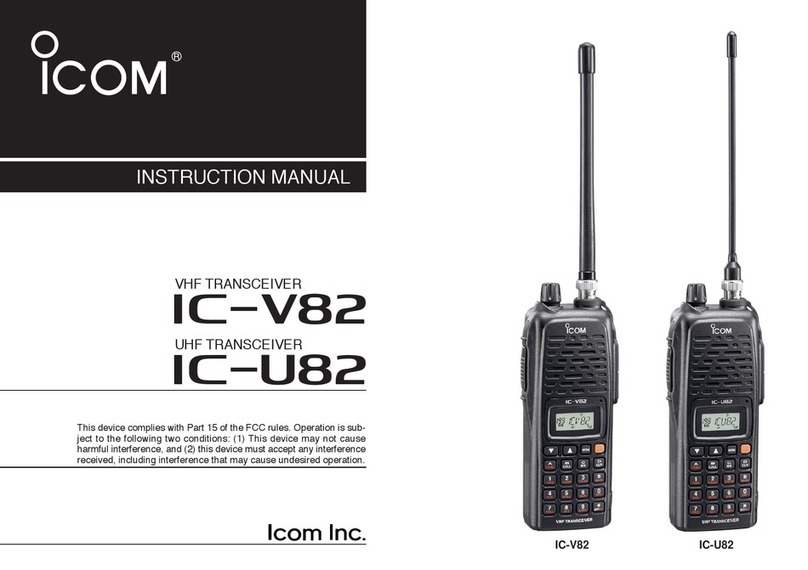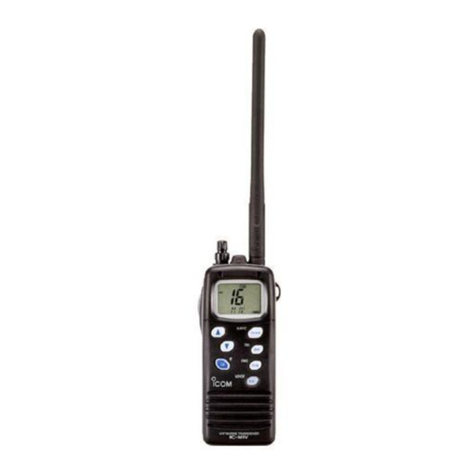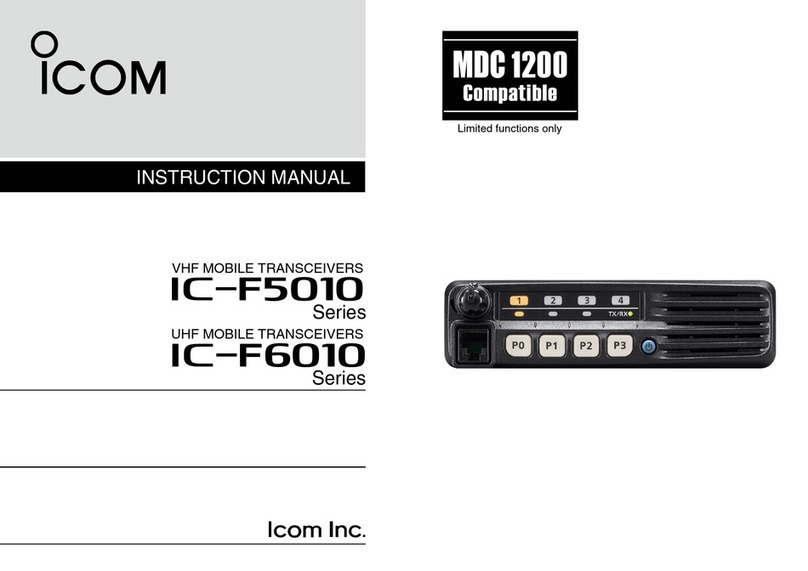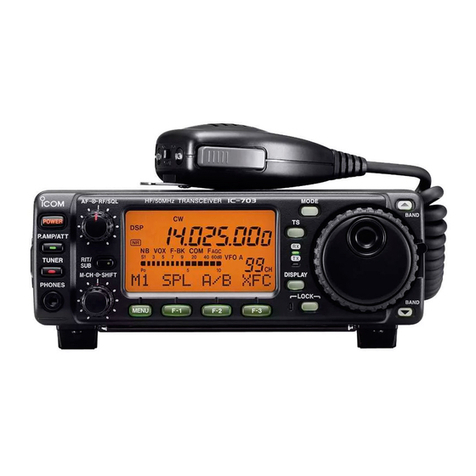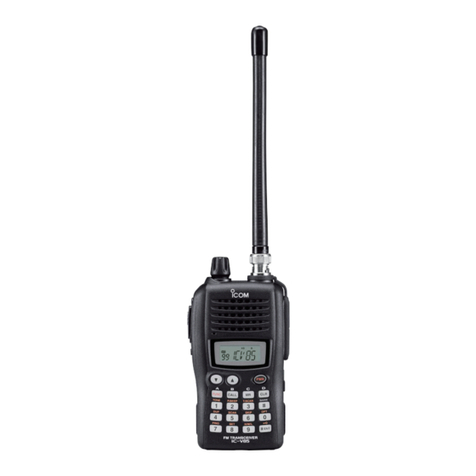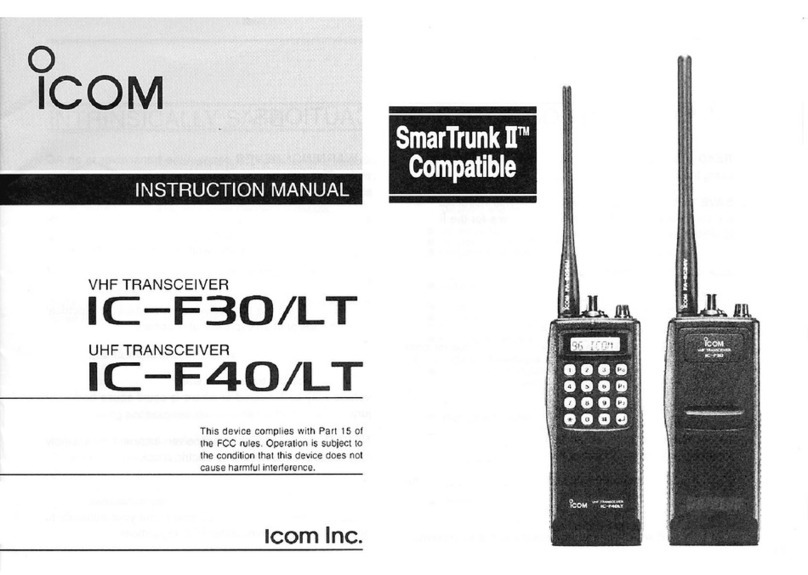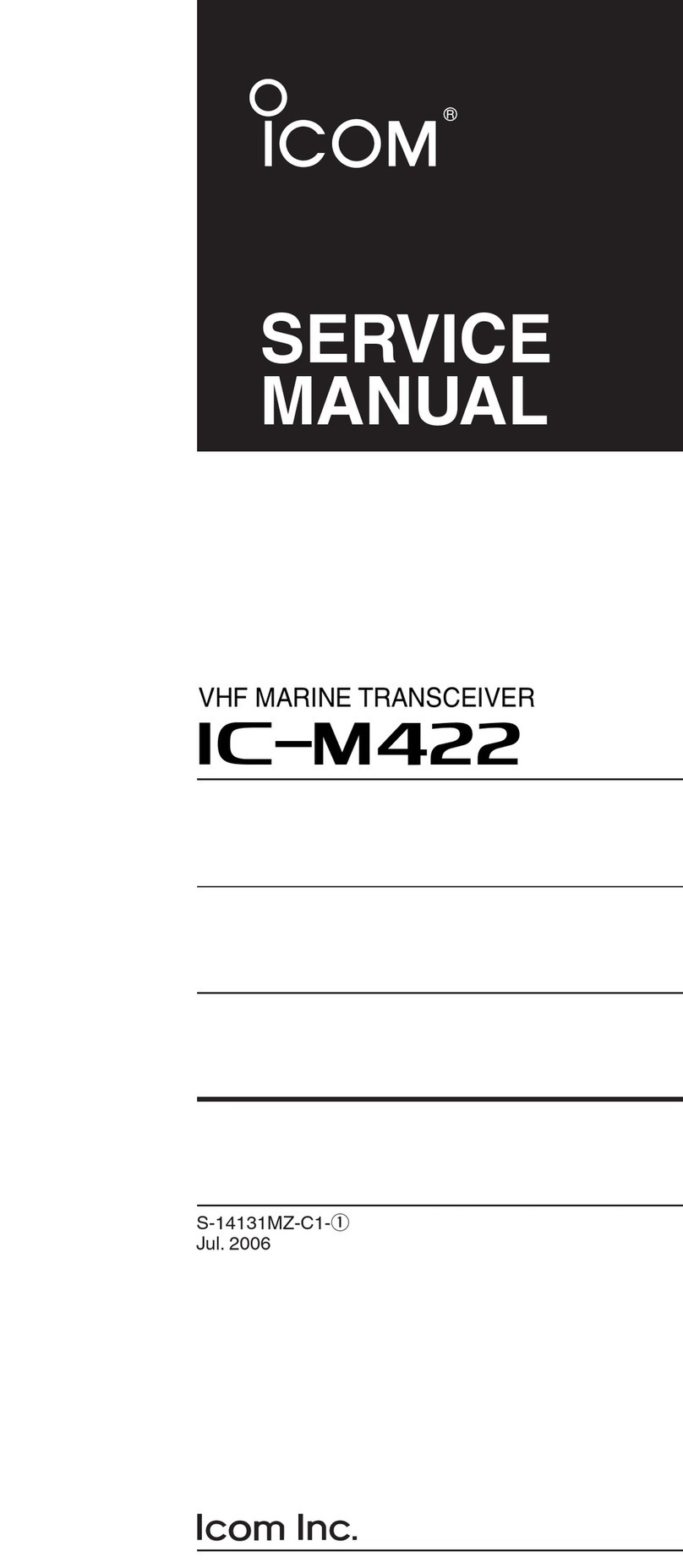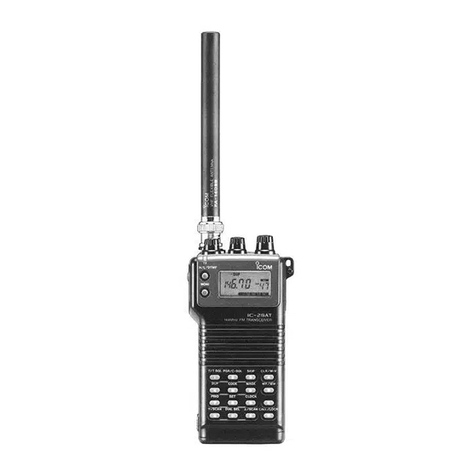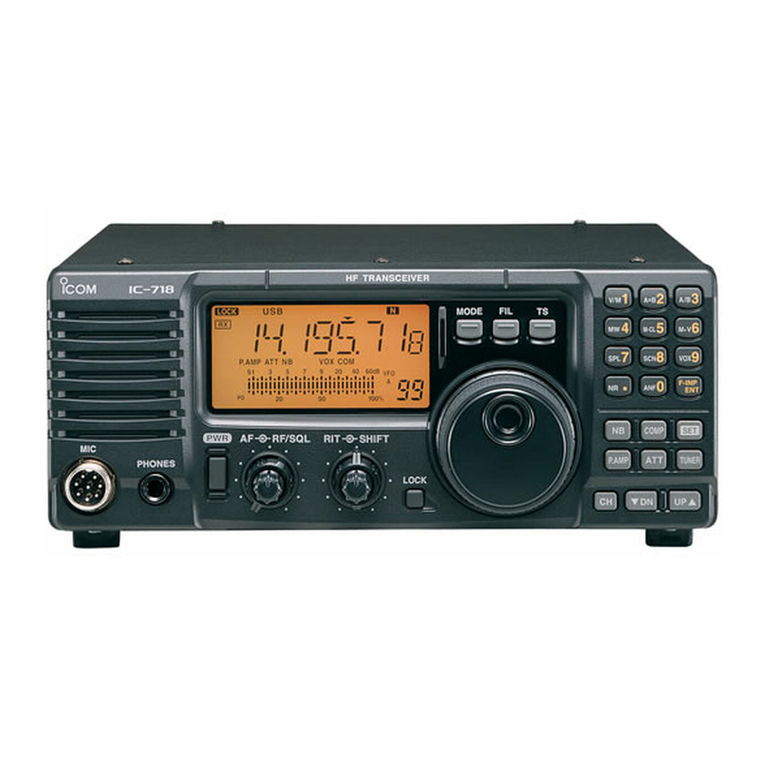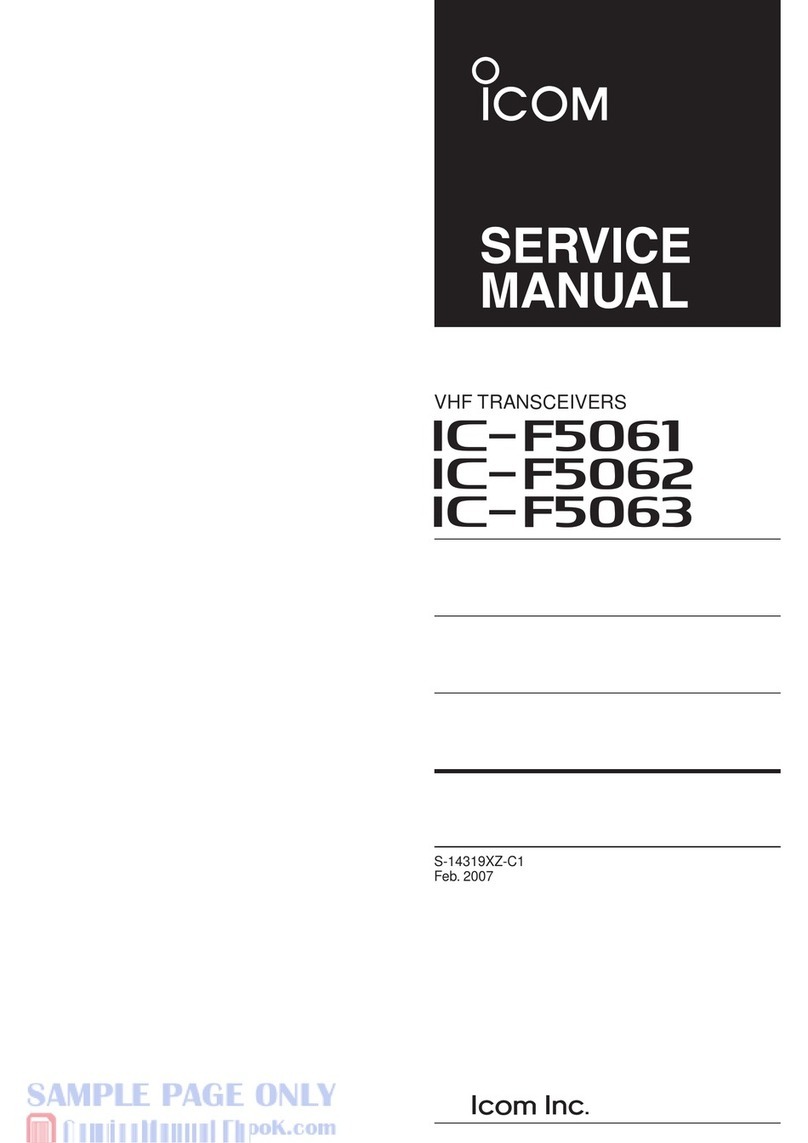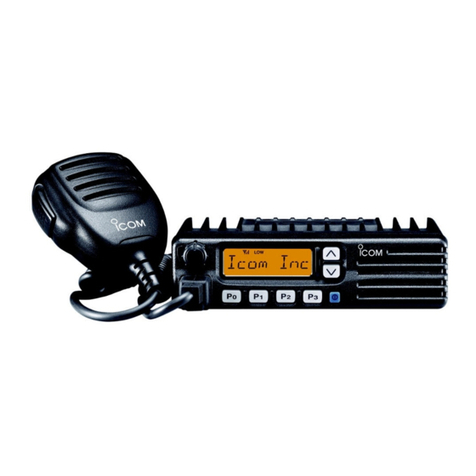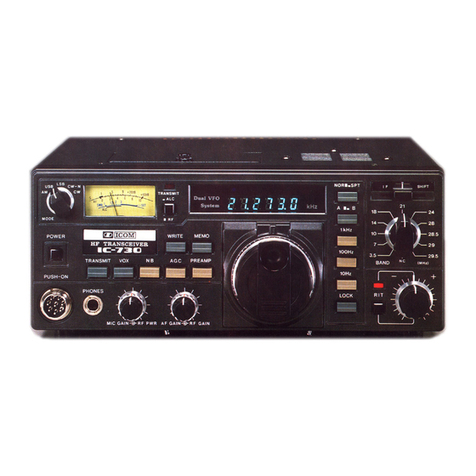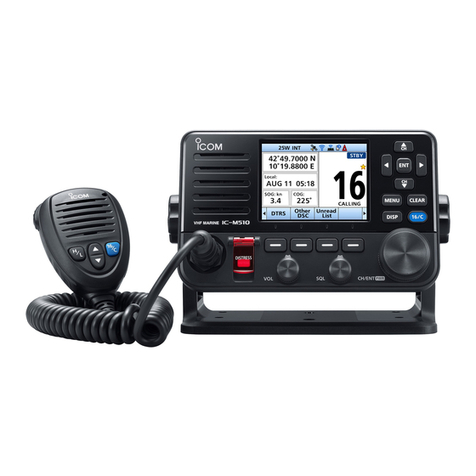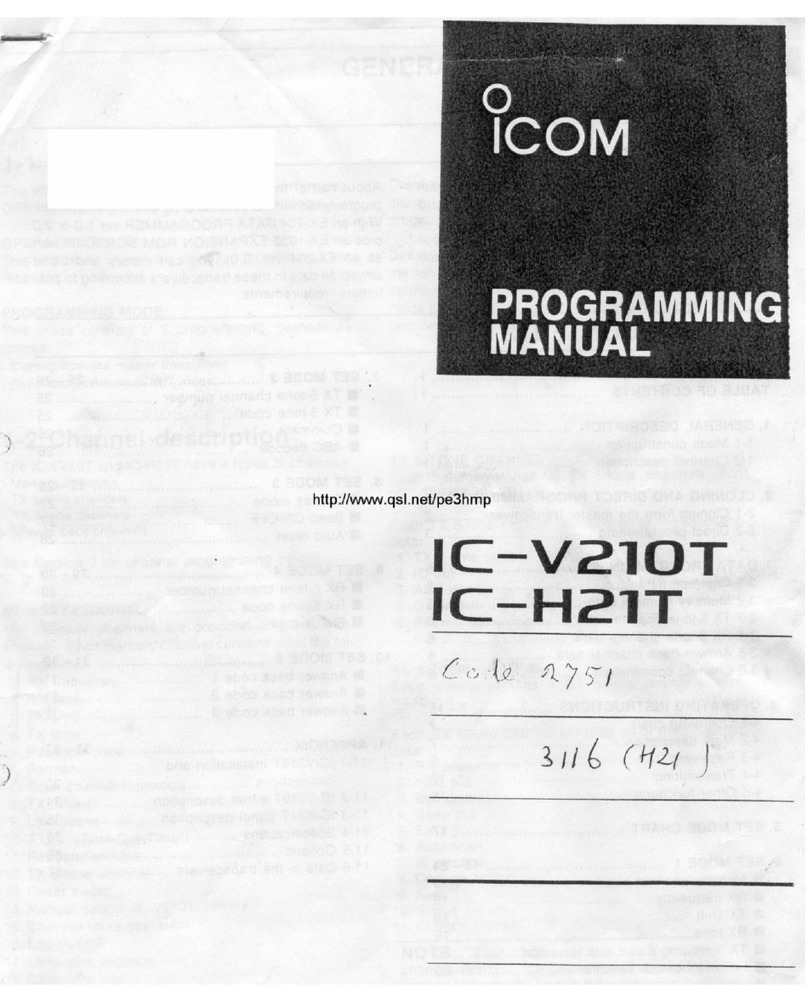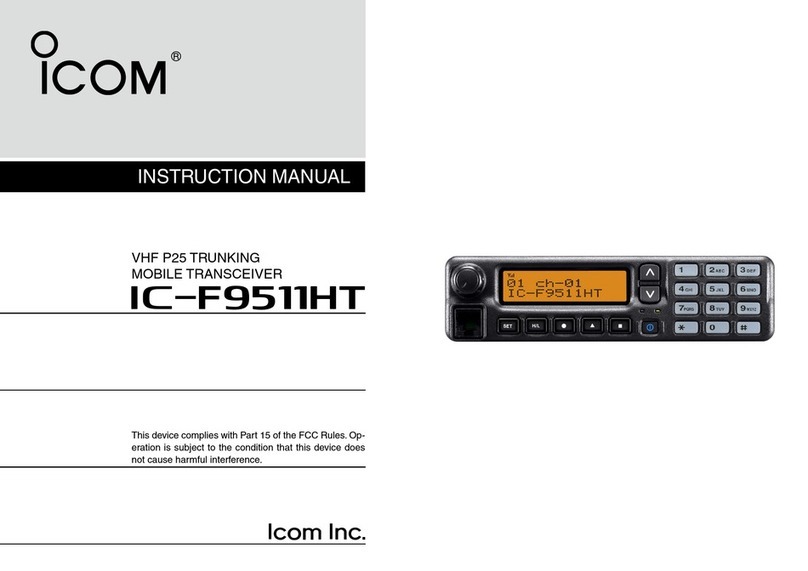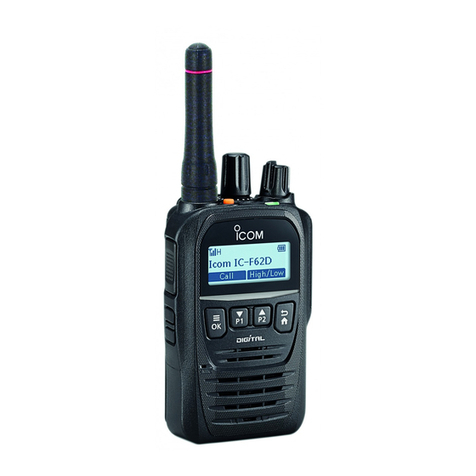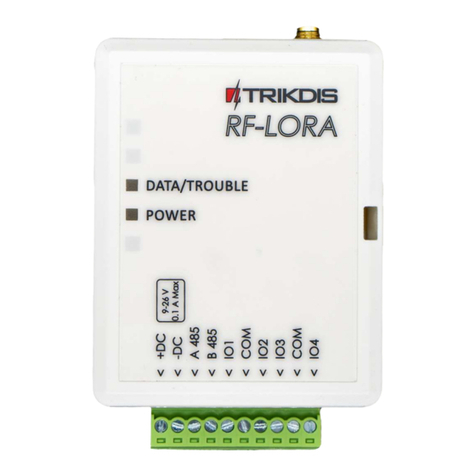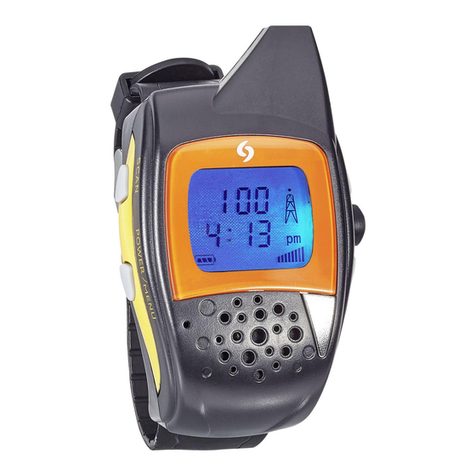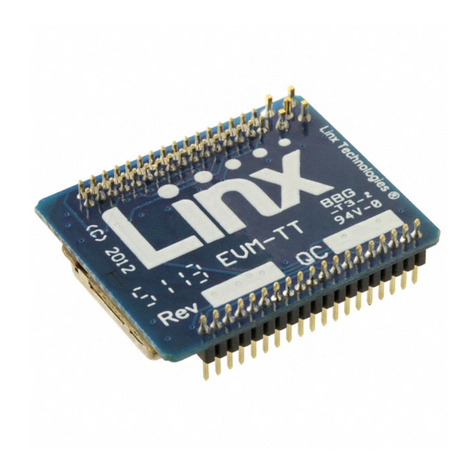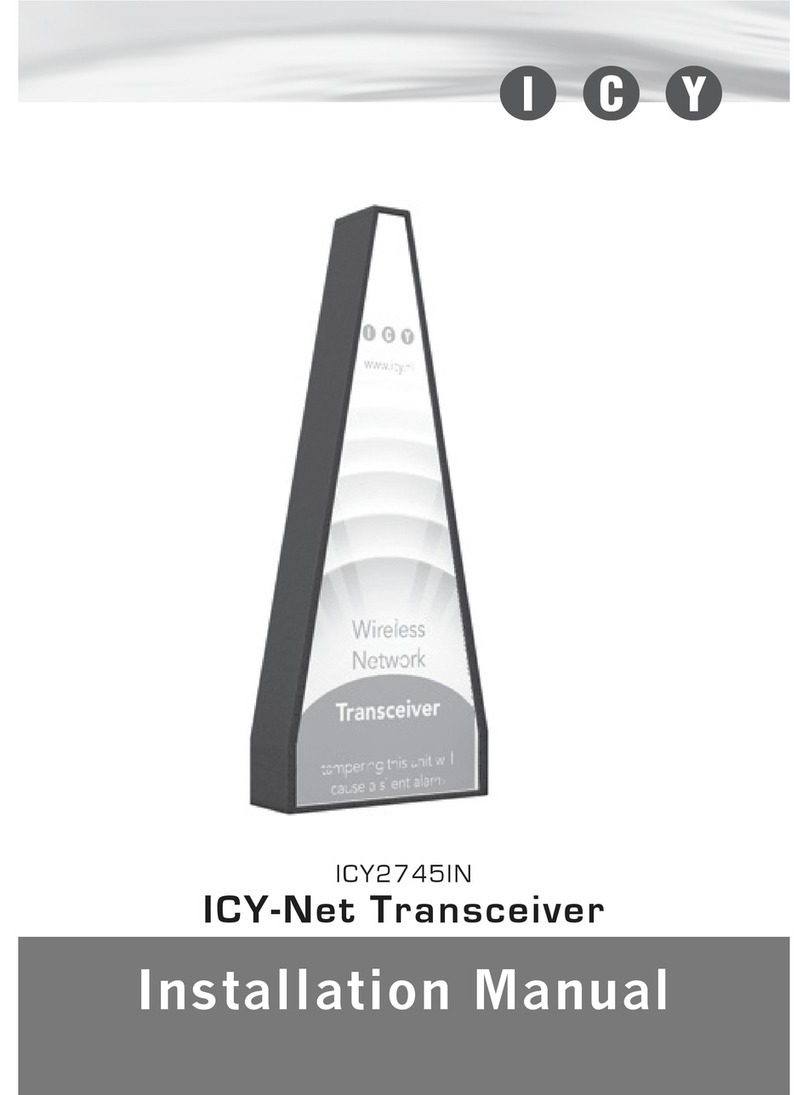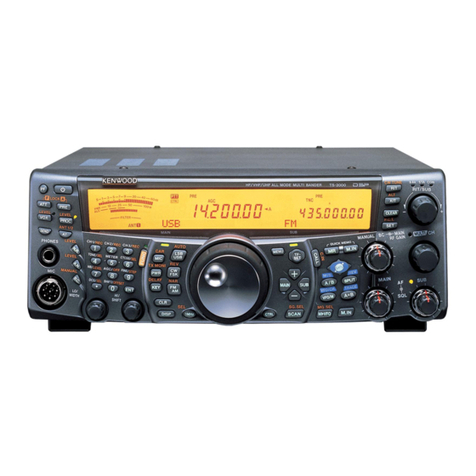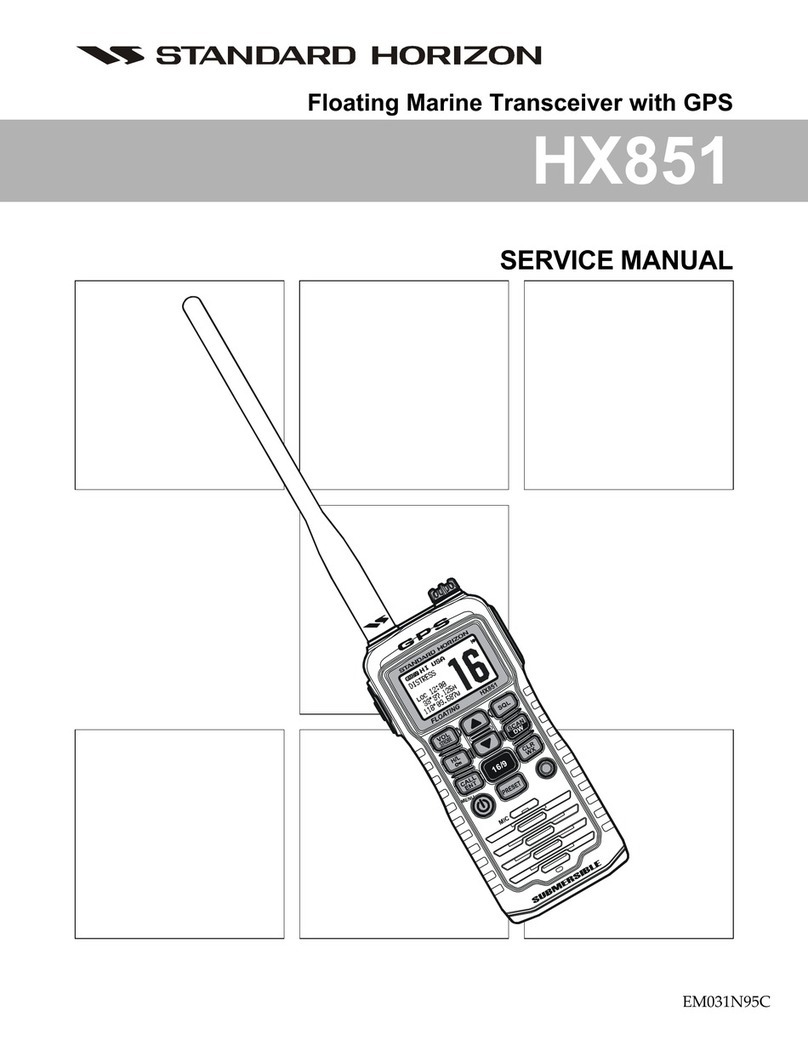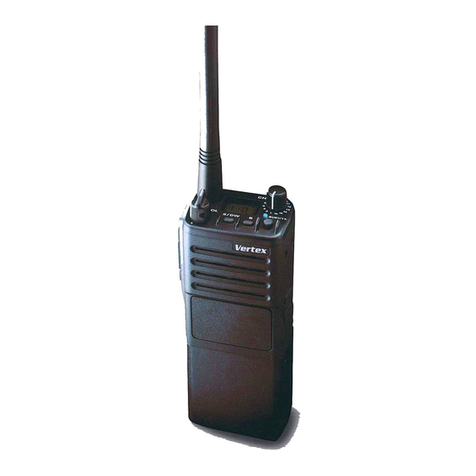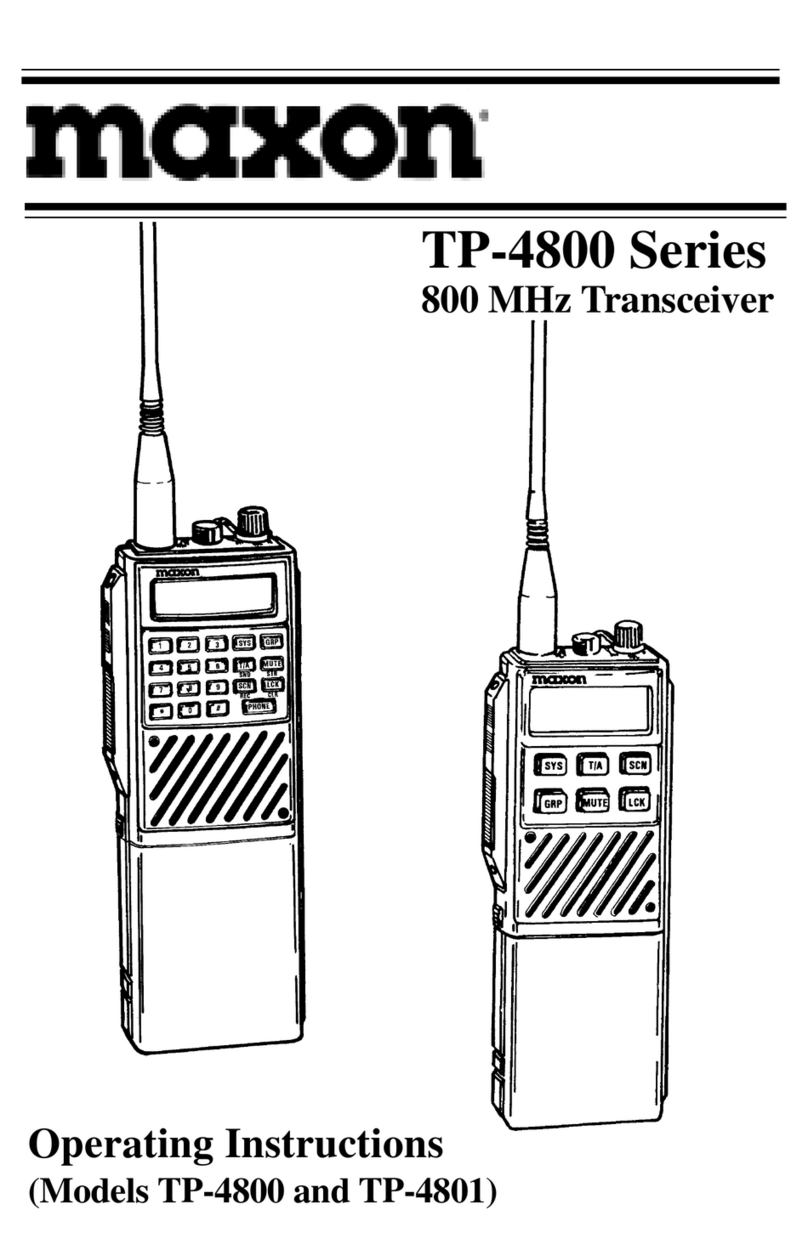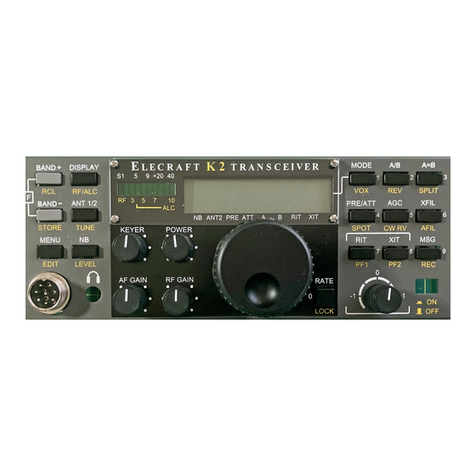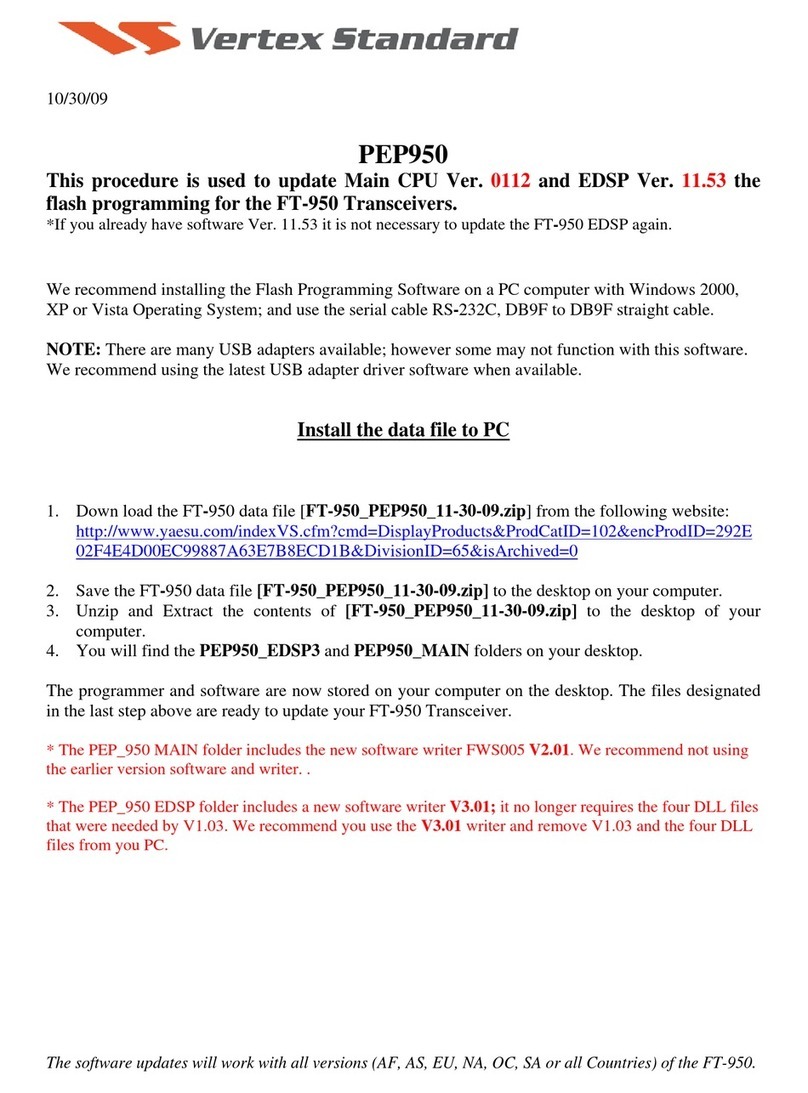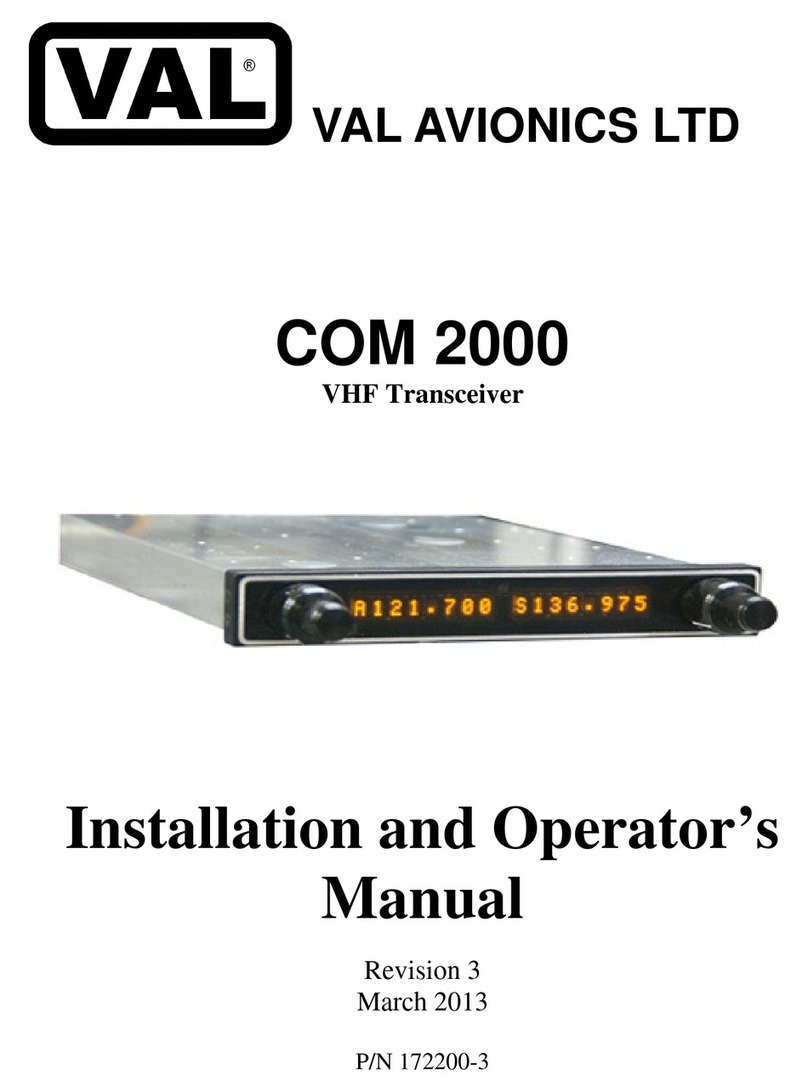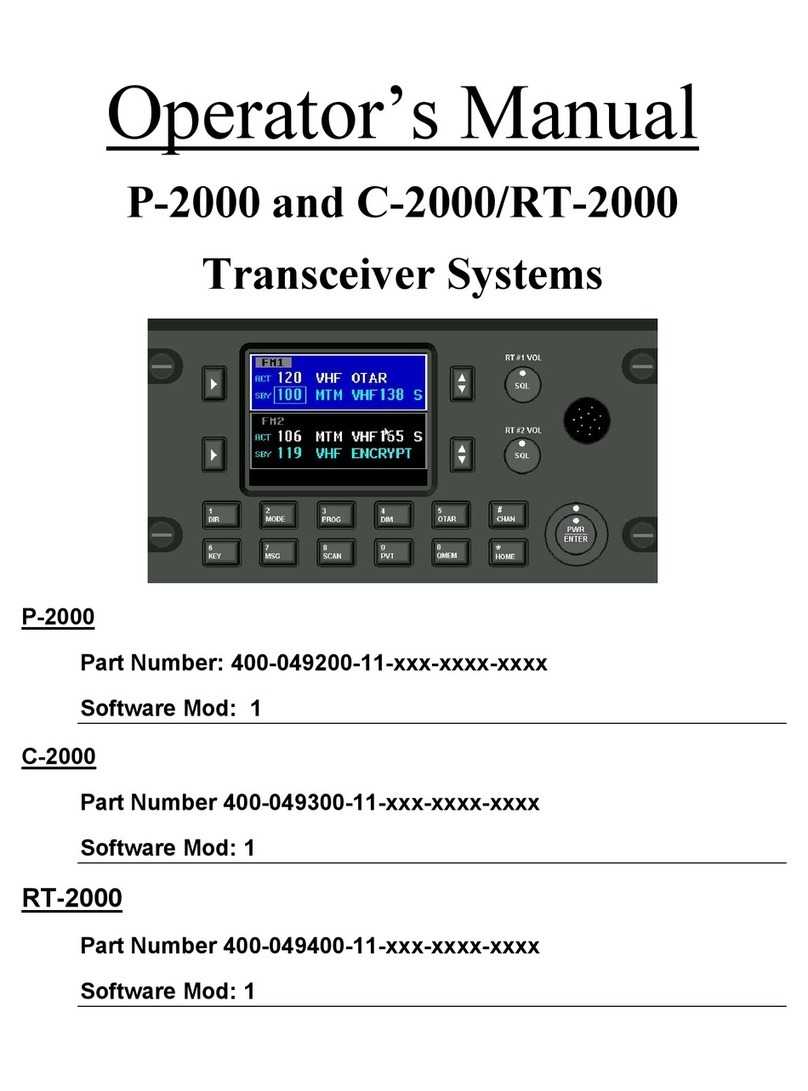Icom IC-F5220D User manual

INSTRUCTION MANUAL
VHF DIGITAL TRANSCEIVER
iF5220D
UHF DIGITAL TRANSCEIVER
iF6220D

i
IMPORTANT
READ ALL INSTRUCTIONS carefully and com-
pletely before using the transceiver.
SAVE THIS INSTRUCTION MANUAL — This
instruction manual contains important operating instructions
for the IC-F5220D VHF DIGITAL TRANSCEIVER and the IC-
F6220D UHF DIGITAL TRANSCEIVER.
See the operating guide for details of IDAS (ICOM Digital
Advanced System) system operations. Ask your dealer for
details.
EXPLICIT DEFINITIONS
WORD DEFINITION
RWARNING! Personal injury, fire hazard or electric
shock may occur.
CAUTION Equipment damage may occur.
NOTE If disregarded, inconvenience only. No risk
of personal injury, fire or electric shock.
FCC INFORMATION
• FOR CLASS A UNINTENTIONAL RADIATORS:
This equipment has been tested and found to comply with the
limits for a Class A digital device, pursuant to part 15 of the
FCC Rules. These limits are designed to provide reasonable
protection against harmful interference when the equipment
is operated in a commercial environment. This equipment
generates, uses, and can radiate radio frequency energy
and, if not installed and used in accordance with the instruc-
tion manual, may cause harmful interference to radio com-
munications.
Operation of this equipment in a residential area is likely to
cause harmful interference in which case the user will be re-
quired to correct the interference at his own expense.
CAUTION: Changes or modifications to this transceiver,
not expressly approved by Icom Inc., could void your au-
thority to operate this transceiver under FCC regulations.

ii
PRECAUTIONS
RWARNING! NEVER connect the transceiver to an
AC outlet. This may pose a fire hazard or result in an electric
shock.
RWARNING! NEVER connect the transceiver to a
power source of more than 16 V DC or use reverse polarity.
This could cause a fire or damage the transceiver.
RWARNING! NEVER cut the DC power cable be-
tween the DC plug and fuse holder. If an incorrect connection
is made after cutting, the transceiver might be damaged.
RWARNING! NEVER place the transceiver where
normal operation of the vehicle may be hindered or where it
could cause bodily injury.
CAUTION: NEVER allow children to touch the trans-
ceiver.
CAUTION: NEVER expose the transceiver to rain,
snow or any liquids.
USE the specified microphone only. Other microphones
have different pin assignments and may damage the trans-
ceiver.
DO NOT use or place the transceiver in areas with tem-
peratures below –30°C (–22°F) or above +60°C (+140°F), or
in areas subject to direct sunlight, such as the dashboard.
DO NOT operate the transceiver without running the ve-
hicle’s engine. The vehicle’s battery will quickly run out when
the transceiver transmits while the vehicle’s engine is OFF.
DO NOT place the transceiver in excessively dusty envi-
ronments.
DO NOT place the transceiver against walls. This will ob-
struct heat dissipation.
DO NOT use harsh solvents such as benzine or alcohol
when cleaning, as they will damage the transceiver surfaces.
BE CAREFUL! The transceiver will become hot when
operating continuously for long periods of time.
Icom, Icom Inc. and the Icom logo are registered trademarks of Icom
Incorporated (Japan) in Japan, the United States, the United King-
dom, Germany, France, Spain, Russia and/or other countries.
All other products or brands are registered trademarks or trademarks
of their respective holders.

iii
VOICE CODING TECHNOLOGY
The AMBE+2™ voice coding Technology embodied in this
product is protected by intellectual property rights including
patent rights, copyrights and trade secrets of Digital Voice Sys-
tems, Inc. This voice coding Technology is licensed solely for
use within this Communications Equipment. The user of this
Technology is explicitly prohibited from attempting to extract,
remove, decompile, reverse engineer, or disassemble the Ob-
ject Code, or in any other way convert the Object Code into a
human-readable form. U.S. Patent Nos.
#5,870,405, #5,826,222, #5,754,974, #5,701,390, #5,715,365,
#5,649,050, #5,630,011, #5,581,656, #5,517,511, #5,491,772,
#5,247,579, #5,226,084 and #5,195,166.
TABLE OF CONTENTS
IMPORTANT .......................................................................... i
EXPLICIT DEFINITIONS....................................................... i
FCC INFORMATION ............................................................. i
PRECAUTIONS.................................................................... ii
VOICE CODING TECHNOLOGY ........................................ iii
TABLE OF CONTENTS....................................................... iii
1 PANEL DESCRIPTION................................................1–5
Front panel
■...................................................................1
Function display
■...........................................................2
Programmable function keys
■........................................3
2 BASIC OPERATION....................................................6–8
Turning ON the power
■..................................................6
Channel selection
■........................................................6
Receiving and transmitting
■...........................................7
User Set mode
■.............................................................8
Priority A channel selection
■..........................................8
3 CONNECTION AND MAINTENANCE ......................9–12
Rear panel connection
■.................................................9
Supplied Accessories
■.................................................10
Mounting the transceiver
■............................................10
Antenna
■......................................................................11
Fuse replacement
■......................................................11
Cleaning
■.....................................................................11
Options
■.......................................................................12
4 SAFETY TRAINING INFORMATION.......................13–16

1
1
PANEL DESCRIPTION
1
2
3
4
5
6
7
8
9
10
11
12
13
14
15
16
q w
t
SpeakerFunction display (p. 2)
r
e
Front panel
■
qAF VOLUME CONTROL KNOB [VOL]
Rotate the knob to adjust the audio output level.
•Minimumaudiolevelispreprogrammed.(p.8)
wUP/DOWN KEYS [UP]/[DOWN]
Push to select an operating channel and so on.
* The desired function can be assigned by your dealer. (p. 3)
ePOWER KEY [ ]
Push to turn the power ON or OFF.
•ThefollowingoptionalfunctionsareavailableatpowerON:
- Automatic scan start
- Password prompt
r DEALER-PROGRAMMABLE KEYS
Required functions can be independently programmed by
your dealer. (p. 3)
tMICROPHONE CONNECTOR
Connect the supplied or optional microphone.
See page 10 for detail of the PTT switch and a hanger
hook operations.
NEVER connect non-specified microphones. The pin
assignments may be different and may damage the
transceiver.

2
1PANEL DESCRIPTION
Function display
■
q w e r t y u i o
!0
q TRANSMIT ICON
Appears while transmitting a signal.
w BUSY ICON
Appears while the channel is busy (receiving).
e SIGNAL STRENGTH ICON
Shows the relative receive signal strength level.
Weak Receive Signal level Strong
About “ ” icon for the Trunking mode
Disappears while in the no service area.➥
Blinks while registering to the repeater.➥
Appears when the registration is completed.➥
r LOW POWER ICON
Appears when low output power is selected.
tAUDIBLE ICON
In the analog mode, appears when the CTCSS (DTCS)➥
squelch mute is released while holding down [Monitor].
In the digital mode, appears while holding down [Moni-➥
tor].
y GPS ICON
Appears when the GPS receiver acquires the received
GPS signal from a satellite.
uENCRYPTION ICON
In the digital mode, appears when the encryption function
is activated.
iBELL ICON
In the digital mode, appears/blinks when a SDM (Short
Data Message), Status Call or Call Alert is received, de-
pending on the preprogramming.
oSCAN ICON
Blinks during a scan.➥
Appears when a scan channel is selected.➥
!0 ALPHANUMERIC DISPLAY
Displays an operating channel number, channel name,
User Set mode contents, and so on.

3
1
PANEL DESCRIPTION
1
2
3
4
5
6
7
8
9
10
11
12
13
14
15
16
Programmable function keys
■
The following functions can be assigned to [UP], [DOWN],
[P0], [P1], [P2] and [P3] programmable function keys.
Consult your Icom dealer or system operator for details con-
cerning your transceivers programming.
NOTE: The function keys for the digital mode are described
in the operating guide.
CH UP AND DOWN
As described in the following topics, after pushing a pro-
grammed key, push [CH Up] or [CH Down] to select an op-
tion, setting, and so on.
ZONE
Push this key, then select the desired zone using [CH Up]/
[CH Down].
What is “zone”?— Certain channels are grouped togeth-
er and assigned to a zone, according to their intended to
use. For example, ‘Staff A’ and ‘Staff B’ are assigned to a
“Business” zone, and ‘John’ and ‘Cindy’ are assigned to a
“Private” zone.
SCAN START/STOP
Push to start and cancel a scan.➥
•WhenascanisstartedwiththePowerONScanorAutomatic
scan function, push this key to cancel it. The cancelled scan re-
sumes after the preprogrammed time period.
➥ Hold down this key for 1 second to display the scan group,
then push [CH Up] or [CH Down] to select the desired
one.
SCAN ADD/DEL (TAG)
Push to add the channel to, or delete it from, the current➥
scan group.
1. Hold down to display the scan group, then push [CH Up] or
[CH Down] to select the desired one.
2. Push to add the channel to, or delete it from, the selected scan
group.
3. Hold down for 1 second to exit the scan list selection mode.
While a scan is paused on a non-priority channel, push this➥
key to delete the selected channel from the scan group.
Depending on the setting, the cleared channel is added
to the scan group again after the scan is cancelled.

4
1PANEL DESCRIPTION
Programmable function keys (Continued)■
PRIORITY A CHANNEL, PRIORITY B CHANNEL
Push to select the Priority A or Priority B channel.
PRIORITY A CHANNEL (REWRITE),
PRIORITY B CHANNEL (REWRITE)
Push to select the Priority A or Priority B channel.➥
Hold down [Prio A (Rewrite)] or [Prio B (Rewrite)] for➥
1 second to assign the operating channel to Priority A or
Priority B channel, respectively.
MEMORY CHANNELS 1, 2, 3, 4
Push to directly select memory channel 1, 2, 3 or 4, if pro-
grammed.
Consult your dealer for details.
MONITOR
Push to turn the CTCSS (DTCS) squelch mute ON or OFF.
LIGHT
Push to turn ON the backlight for about 5 seconds, when the
backlight function is set to “OFF” in the User Set mode.
HIGH/LOW
Push to select the transmit output power temporarily or per-
manently, depending on the preprogramming.
•Askyourdealerfortheoutputpowerlevelforeachselection.
LOCK
Hold down this key until “LOCK ON” is displayed to elec-➥
tronicallylockallprogrammablekeysexceptthefollowing:
[Moni], [Lock], [Emergency]*, [Power OFF Emergency]*,
[Surveillance], [Siren], [Lone Worker]*, [Light] and [Shift].
*For digital operation. See the operating guide for details
To turn OFF the Key Lock function, hold down this key until➥
“LOCK OFF” is displayed.
TALK AROUND
Push to turn the Talk Around function ON or OFF.
•TheTalkAround functionequalizes thetransmitfrequencytothe
receive frequency for transceiver-to-transceiver communication.
WIDE/NARROW
Push to toggle the IF bandwidth between wide and narrow.
SURVEILLANCE
Push to turn the surveillance function ON or OFF.
When this function is turned ON and a signal is received, the
beep is not heard and the LED does not light, even if a key
is pushed.
SIREN
Hold down for 1 second to sound the siren.
This function can be used for situations other than an emer-
gency alert, such as a security alarm for example.
•ThesirencanonlybestoppedbyturningOFFthetransceiverpower.

5
1
PANEL DESCRIPTION
1
2
3
4
5
6
7
8
9
10
11
12
13
14
15
16
HOOK SCAN
When the Hook Scan function is preprogrammed, push this
key to temporarily disable the function. Push this key again to
enable the function.
USER SET MODE
Hold down for 1 second to enter the User Set mode.➥
•WhileintheUserSetmode,pushthiskeytoselectanitem*,and
change the value or setting using [CH Up] or [CH Down].
*Selectable items may differ, depending on the preprogram-
ming.
Hold down this key for 1 second again to exit the User Set➥
mode.
EXT. CH SEL MODE
Push to turn the Ext. CH Select function ON or OFF.
When the function is turned ON, memory channels can be
selected with only an external input.
When the function is turned OFF, memory channels can be
selected by pushing [CH Up] or [CH Down], and cannot be
externally controlled.
•Thisfunctionisusablewhenan external unit, suchas a dimmer
control is connected to the transceiver with an optional OPC-1939
or OPC-2078 cable (p. 12).
•Askyourdealerformoredetailsonexternalinputoperation.
ANNOUNCE
Push to turn the Channel Announce function ON or OFF.
When this function is turned ON, the transceiver announces
the channel number when it is selected.
RESET
Push to return to the normal operating mode.➥
While in the audible mode, push to return to the inaudible➥
mode.
NOTE: See the operating guide for the [Reset] key opera-
tions in the digital mode.
GPS DISPLAY
Push to switch the display mode between stand-by and GPS
position data.
SHIFT
Push to switch the Normal mode key functions and the Shift
mode key functions.
•WhentheShiftmodeisselected,thedisplaybrieyshows“SHIFT
ON.”WhentheNormalmodeisselected,thedisplaybrieyshows
“SHIFT OFF.”

6
2BASIC OPERATION
Turning ON the power
■
Pushq[ ] to turn ON the power.
If the transceiver is programmed for a start up password,w
input the digit codes that were set by your dealer.
•Thekeysshownbelowcanbeusedforpasswordinput:
The transceiver detects numbers in the same block as identical.
Therefore “01234” and “56789” are the same.
KEY
NUMBER 0
5
4
9
3
8
2
7
1
6
If the “PASSWORD” indication does not clear after input-e
ting 6 digits, the input code number may be incorrect. Turn
OFF the power and re-enter your password.
Channel selection
■
There are several ways to select channels, and they may dif-
fer, depending on your system set up.
NON-ZONE TYPE:
Toselectthedesiredoperatingchannel:
Push [CH Up] or [CH Down].➥
Push one of [MR-CH 1] to [MR-CH 4].➥
ZONE TYPE:
Toselectthedesiredoperatingchannel:
Push [Zone], then push [CH Up] or [CH Down].➥
VOTING OPERATION:
The transceiver automatically starts scanning when a zone,
specified for the voting operation, is selected.
The voting scan detects the S-meter of the repeater and au-
tomatically selects the strongest station.
AUTOMATIC SCAN TYPE:
Channel setting is not necessary for this type. When turning
ON the power, the transceiver automatically starts scanning.
Scanning stops when a signal is detected.

7
2
BASIC OPERATION
1
2
3
4
5
6
7
8
9
10
11
12
13
14
15
16
Receiving and transmitting
■
Receiving:
Hold downq[]for 1 second to turn ON the power.
Push [CH Up] or [CH Down] to select a channel.w
When receiving a call, rotate [VOL] to adjust the audio out-e
put level to a comfortable listening level.
Transmitting:
Wait for the channel to become clear to avoid interference.
Take the microphone OFF hook.q
•The‘Audible’modeisselected.
•Aprioritychannelmaybeautomaticallyselected.
Wait for the channel to become clear.w
•
The channel is busy when the BUSY icon appears on the LCD.
While holding down [PTT], speak into the microphone ate
your normal voice level.
Release [PTT] to return to receive.r
IMPORTANT: To maximize the readability of your signal;
1.Pausebrieyafterpushing[PTT].
2. Hold the microphone 5 to 10 cm (2 to 4 inches) from
your mouth, then speak into the microphone at a normal
voice level.
Transmitting notesD
• Transmit inhibit function
The transceiver has several inhibit functions which restrict
transmissionunderthefollowingconditions:
- The channel is busy. However, depending on the preprogrammed
settings, you can transmit when the call includes an unmatching
(or matching) CTCSS (DTCS), RAN code*, or Individual or Talk-
group ID*.
* Digital operation only
- The selected channel is a ‘receive only’ channel.
• Time-out timer
If continuous transmission exceeds the preprogrammed
time-out timer limit, the transmission is cut off.
• Penalty timer
After the transmission is cut off by the time-out timer, trans-
mission is further inhibited for the preprogrammed penalty
timer period.

8
2BASIC OPERATION
User Set mode
■
The User Set mode allows you to set seldom-changed set-
tings. If the transceiver has [User Set Mode] assigned to it,
you can “customize” the transceiver operation to suit your
preferences and operating style.
Entering the User Set mode:
Hold down [User Set Mode] for 1 second to enter the Userq
Set mode.
Push [User Set Mode] several times to select the appro-w
priate item. Then push [CH Up] or [CH Down] to set the
desired level/condition.
•SelectableSetmodeitemsareBacklight, Beep ON/OFF, Beep
Level, Ringer Level, SQL Level, AF Min Level, Mic Gain,
Horn, Battery Voltage, Signal Moni, Lone Worker and Sys-
tem Info.
Hold down [User Set Mode] for 1 second again to exit thee
User Set mode.
Priority A channel selection
■
When one of the following operations is performed, the trans-
ceiver automatically selects the Priority A channel.
• Turning ON the power
The Priority A channel is selected each time the transceiv-
er power is turned ON.
• Auto Reset
The Priority A channel is selected when the Auto Reset
timer ends.
• OFF hook
The Priority A channel is selected when you take the mi-
crophone OFF hook.

9
3
CONNECTION AND MAINTENANCE
1
2
3
4
5
6
7
8
9
10
11
12
13
14
15
16
e
r
Antenna
Black
Red
12V
Battery
Solder
Crimp
NOTE: Use terminals for the cable
connections.
qANTENNA CONNECTOR
Connect to an antenna. Ask your
dealer about antenna selection
and placement.
qw
wEXTERNAL SPEAKER JACK
Connect to a 4 to 8 øexternal speaker.
eMICROPHONE HANGER
Connect the supplied micro-
phone hanger to the vehicle’s
ground for microphone ON/OFF
hook functions. (See page 1)
r
OPTIONAL OPC-1939 or OPC-2078 CABLE
t
tDC POWER RECEPTACLE
Connect to a 12 V DC battery.
Pay attention to polarities.
Optional speaker
Connect an external modem, dimmer
control, and so on.
NOTE: No Digital Modulation “IN” using
accessory cables.
RWARNING! NEVER connect
to a 24 V battery. This could
damage the transceiver.
RW ARNING! NEVER remove the
fuse holders from the DC power cable.
Rear panel connection
■

10
3CONNECTION AND MAINTENANCE
Supplied Accessories
■
Microphone
D
The supplied
or optional
microphone has a PTT switch and a
hanger hook.
•Thefollowingfunctionsareavailablewhenthemicrophone
isONorOFFhook(dependingonthepreprogramming):
- Automatic scan starts when you put it ON hook.
- Scan is cancelled when you take it OFF hook.
- Scan is paused when you take it OFF hook.
- Automatically selects the Priority channel when you take it OFF hook.
- Sets to the ‘Inaudible’ mode (mute state) when you put it ON hook.
- Sets to the ‘Audible’ mode (unmute state) when you take it OFF
hook.
Microphone Microphone hanger
and screw set
Microphone
hanger cable
DC power cable
Flat washers
Spring washers Bracket bolts
Mounting screws
(5 × 12)
Self-tapping screws
(5 × 20)
Nuts
Function name
stickers*
Used for labelling the programmable function
keys according to their assigned functions.
*
Mounting bracket

11
3
CONNECTION AND MAINTENANCE
1
2
3
4
5
6
7
8
9
10
11
12
13
14
15
16
Mounting the transceiver
■
The universal mounting bracket supplied with your transceiv-
er allows overhead mounting.
•Mountthetransceiversecurelywiththe4suppliedscrewstoathick
surface which can support more than 1.5 kg (3.3 lb).
Flat washer
Felt*
Spring washer
When using
self-tapping screws *Felt reduces the effects of vibration.
Antenna
■
A key element in the performance of any communication sys-
tems is its antenna. Contact your dealer for more information
regarding antennas and how to install them.
Fuse replacement
■
A fuse is installed in each fuse holder of the supplied DC
power cable. If a fuse blows or the transceiver stops function-
ing, track down the source of the problem if possible, repair it
and then replace the damaged fuse with a new rated one.
❑Fuserating:20A
USE only the applicable fuse.

12
3CONNECTION AND MAINTENANCE
Cleaning
■
If the transceiver becomes dusty or dirty, wipe it
clean with a soft, dry cloth.
DO NOT use harsh solvents such as benzine or
alcohol, as they will damage the transceiver sur-
faces.
Options
■
• OPC-1132A/OPC-347 d c p o w e r c a b l e
Two fuse holders are attached. USE only the 20 A fuse.
OPC-1132A:3m(9.8ft)
OPC-347:7m(23ft)
• OPC-1939/OPC-2078 a c c c a b l e
Allows you to connect to an external terminal.
OPC-1939:D-sub15-pin,OPC-2078:D-sub25-pin
NOTE:
No Digital Modulation “IN” using accessory cables.
• HM-152/HM-152T/HM-148G/HM-148T h a n d m i c r o p h o n e
HM-152 :Handmicrophone
HM-152T:DTMFmicrophone
HM-148G:Selfgroundheavydutymicrophone
HM-148T:Self-groundingheavydutymicrophonewith10-
key pad. The 10-key pad on this microphone can
be used for the only DTMF code transmission.
• SM-26 d e s k t o p m i c r o p h o n e
• SP-30/SP-35 e x t e r n a l s p e a k e r
Inputimpedance:4ø
Max. input power: 30 W (SP-30)/7 W (SP-35)
SP-30:Highinputpowerlevel.
SP-35:Compactandeasy-to-install.
Approved Icom optional equipment is designed for optimal
performance when used with an Icom transceiver.
Icom is not responsible for the destruction or damage to an
Icom transceiver in the event the Icom transceiver is used with
equipment that is not manufactured or approved by Icom.

13
4
SAFETY TRAINING INFORMATION
1
2
3
4
5
6
7
8
9
10
11
12
13
14
15
16
WARNING
Your Icom radio generates RF electromagnetic en-
ergy during transmit mode. This radio is designed
for and classified as “Occupational Use Only”,
meaning it must be used only during the course of
employment by individuals aware of the hazards,
and the ways to minimize such hazards. This radio
is NOT intended for use by the “General Popula-
tion” in an uncontrolled environment.
•ForcompliancewithFCCandICRFExposureRequirements,the
transmitter antenna installation shall comply with the following two
conditions:
1. The transmitter antenna gain shall not exceed 0 dBi.
2.IC-F5220D:
The antenna is required to be located outside of a vehicle and kept
at a distance of 45 centimeters or more between the transmitting
antenna of this device and any persons during operation. For small
vehicle as worst case, the antenna shall be located on the roof
top at any place on the centre line along the vehicle in order to
achieve 45 centimeters separation distance. In order to ensure this
distance is met, the installation of the antenna must be mounted at
least 45 centimeters away from the nearest edge of the vehicle in
order to protect against exposure to bystanders.
2.IC-F6220D:
The antenna is required to be located outside of a vehicle and kept
at a distance of 37 centimeters or more between the transmitting
antenna of this device and any persons during operation. For small
vehicle as worst case, the antenna shall be located on the roof
top at any place on the centre line along the vehicle in order to
achieve 37 centimeters separation distance. In order to ensure this
distance is met, the installation of the antenna must be mounted at
least 37 centimeters away from the nearest edge of the vehicle in
order to protect against exposure to bystanders.
3.IC-F5220D:
Transmit only when people outside the vehicle are at least the rec-
ommended minimum distance of 100 centimeters away from the
properly installed antenna. This separation distance will ensure
that there is sufficient distance from a properly installed external-
ly-mounted antenna to satisfy the RF exposure requirements in
the applicable RF exposure compliance standards.
3.IC-F6220D:
Transmit only when people outside the vehicle are at least the rec-
ommended minimum distance of 82 centimeters away from the
properly installed antenna. This separation distance will ensure
that there is sufficient distance from a properly installed external-
ly-mounted antenna to satisfy the RF exposure requirements in
the applicable RF exposure compliance standards.

14
4SAFETY TRAINING INFORMATION
CAUTION
To ensure that your exposure to RF electromag-
netic energy is within the FCC and IC allowable
limits for occupational use, always adhere to the
following guidelines:
•DO NOT operate the radio without a proper antenna attached, as
this may damage the radio and may also cause you to exceed FCC
and IC RF exposure limits. A proper antenna is the antenna sup-
plied with this radio by the manufacturer or an antenna specifically
authorized by the manufacturer for use with this radio.
•DO NOT transmit for more than 50% of total radio use time (“50%
duty cycle”). Transmitting more than 50% of the time can cause
FCC and IC RF exposure compliance requirements to be exceed-
ed. The radio is transmitting when the “transmit indicator” appears
on the LCD. You can cause the radio to transmit by pressing the
“PTT” switch.
Electromagnetic Interference/Compatibility
During transmissions, your Icom radio generates RF energy that
can possibly cause interference with other devices or systems. To
avoid such interference, turn OFF the radio in areas where signs are
posted to do so. DO NOT operate the transmitter in areas that are
sensitive to electromagnetic radiation such as hospitals, aircraft, and
blasting sites.

15
4
SAFETY TRAINING INFORMATION
1
2
3
4
5
6
7
8
9
10
11
12
13
14
15
16
Votre radio Icom produit une énergie électro-
magnétique de radiofréquences (RF), en mode
de transmission. Cette radio est conçue pour
un «usage professionnel seulement» et clas-
sée comme tel, ce qui signifie qu'elle doit être
utilisée uniquement dans le cadre d'un travail
par des personnes conscientes des dangers et des mesures
visant à minimiser ces dangers. Elle N'EST PAS conçue pour
une «utilisation grand public», dans un environnement non con-
trôlé.
•An de satisfaire aux exigences de la FCC et d'IC en matière
d'expositionauxRF, il est nécessairequel'antenne soit installée
conformémentauxdeuxconditionssuivantes:
1.Le gain de l'antenne du radio émetteur ne doit pas dépasser
0 dBi.
2.IC-F5220D:
Il faut que l'antenne émettrice de cet appareil soit placée à
l'extérieur d'un véhicule et tenue éloignée d'au moins 45 cen-
timètresdetoutepersonnependantlefonctionnement.Dansle
piredescas,pourunpetitvéhicule,l'antennedoitêtreplacéesur
letoit,n'importeoùdansl'axecentralduvéhicule,anderespect-
erunedistancede45cmdubordleplusrapprochéduvéhiculeet
ainsiéviterquelespersonnesprésentessoientexposées.
2.IC-F6220D:
Il faut que l'antenne émettrice de cet appareil soit placée à
l'extérieur d'un véhicule et tenue éloignée d'au moins 37 cen-
timètresdetoutepersonnependantlefonctionnement.Dansle
piredescas,pourunpetitvéhicule,l'antennedoitêtreplacéesur
letoit,n'importeoùdansl'axecentralduvéhicule,anderespect-
erunedistancede37cmdubordleplusrapprochéduvéhiculeet
ainsiéviterquelespersonnesprésentessoientexposées.
3.IC-F5220D:
Émettreuniquementlorsquelespersonnesàl’extérieurduvéhi-
culesetrouventàaumoinsladistanceminimalerecommandée
de100cmdel’antenne correctement installée. Cettedistance
desécuritéassureraquelespersonnessoientplacéessufsam-
ment loin d’une antenne correctement xée à l’extérieur pour
satisfaireauxexigencesenmatièred’expositionauxRF,envertu
desnormesdeconformitéapplicables.
3.IC-F6220D:
Émettreuniquementlorsquelespersonnesàl’extérieurduvéhi-
culesetrouventàaumoinsladistanceminimalerecommandée
de82cmdel’antennecorrectementinstallée.Cettedistancede
sécurité assurera que les personnes soient placées sufsam-
ment loin d’une antenne correctement xée à l’extérieur pour
satisfaireauxexigencesenmatièred’expositionauxRF,envertu
desnormesdeconformitéapplicables.
AVERTISSEMENT

16
4SAFETY TRAINING INFORMATION
MISE EN GARDE
Afin de vous assurer que votre exposition à
une énergie électromagnétique de RF se situe
dans les limites permises par la FCC et d'IC
pour une utilisation grand public, veuillez en
tout temps respecter les directives suivantes:
•NE PAS faire fonctionner la radio sans qu'une antenne appro-
priéeysoitxée,carcecirisqued'endommagerlaradioetcauser
uneexpositionsupérieureauxlimitesétabliesparlaFCCetd'IC.
L'antenneappropriéeestcellequiestfournieaveccetteradiopar
lefabricantouuneantennespécialementautoriséeparlefabricant
pourêtreutiliséeaveccetteradio.
•NEPASémettrependantplusde50%dutempstotald'utilisationde
l'appareil(«50%dufacteurd'utilisation»).Émettrependantplusde
50%dutempstotald'utilisationpeutcauseruneexpositionauxRF
supérieureauxlimitesétabliesparlaFCCetd'IC.Lorsquelevoy-
antDELrouges’allume,cetteradioestentraind’émettre.Laradio
émettrasivousappuyezsurleboutondumicrophone.
Interférence électromagnétique et compatibilité
Enmodedetransmission,votreradioIcomproduitdel'énergiede
RFquipeutprovoquerdesinterférencesavecd'autresappareilsou
systèmes. Pour éviter de telles interférences, mettez la radio hors
tensiondanslessecteursoùunesignalisationl’exige.NEPASfaire
fonctionnerl'émetteurdansdessecteurssensiblesaurayonnement
électromagnétiquetelsqueleshôpitaux,lesaéronefsetlessitesde
dynamitage.
Other manuals for IC-F5220D
2
This manual suits for next models
1
Table of contents
Other Icom Transceiver manuals
